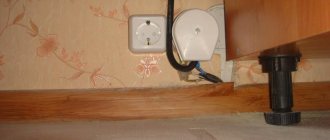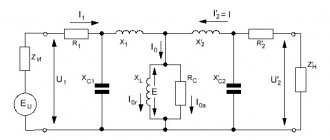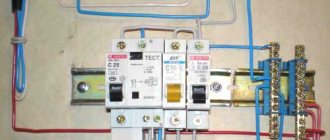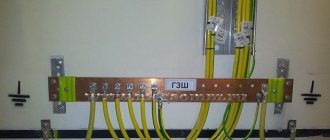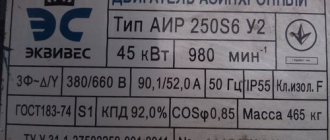Electric shock can cause disability and even death. Therefore, to protect workers during work, many protective devices and tools are used. One of them is considered to be an insulating rod - these are special rods that are made of non-conducting materials. They can touch electrical installations that are energized. They also serve as a rescue element (freeing the victim from the effects of electricity).
Definition and purpose
The insulating rod is designed to isolate a specialist from live elements when working with equipment. The device is used in many cases. Some models provide the use of a set of interchangeable heads. These devices are used in the following cases:
- For installation of mobile grounding – as a tool to ensure the safety of specialists working in de-energized areas. This is necessary for those cases where there is a possibility of incomplete disconnection from the static and induced potential;
- For installation of fuses in electrical installations whose voltage is more than 1 kV. In this case, a replaceable tip is used, which is equipped with a soft gasket to protect the fuse bulb from mechanical damage when exposed to impact;
- For turning on or closing knives. Often the electrical installation device allows you to carry out work on switching positions using a rod;
- To check the insulation on individual elements in garlands. The insulating rod applies the test voltage to each plate in turn;
- To check the absence of voltage. Typically, a voltage indicator is used for these purposes. In cases where approaching a current-carrying installation is difficult due to distance, an insulating rod is used, on which a head is installed, signaling the presence of voltage;
- To find weak points in fastenings. Using this device, the nodes where the tires are fixed are checked. This device can be used to detect heating or chattering, as well as other alarming phenomena;
- To isolate from the action of current in cases where the wire falls on a person or installation. Using a rod, the wire can be removed to the required distance.
Also read: What is the difference between a transformer and an autotransformer?
Working with an insulating rod
An insulating rod can be used in other cases, depending on the situation.
Terms of use
Rice. 5: how to use an insulating rod To ensure safety during any manipulations, a number of rules must be followed. Thus, in electrical installations of more than 1 kV it is necessary to wear dielectric gloves and a face shield. Since in the event of voltage on the elements of an electrical installation, gloves act as an additional protective device designed to prevent potential contact with a person in any emergency situations. The gloves themselves, as well as the insulating rod, must be checked before starting work for integrity and compliance with the test dates.
Design of insulating rods
The design of this element is a pole, which consists of several segments. Individual parts of the element may differ in size and design, depending on the lines with which the rods will be used.
The design of these devices consists of the following elements:
- pens;
- restrictive ring;
- insulating and working parts.
The design of any rod is divided into the three above segments. Devices can be folding, telescopic and monolithic types. There are several types depending on the scope of their application.
"Ticks"
A separate item worth highlighting is insulating pliers. The element allows you to replace fuses in electrical installations up to 1 kV and higher. They are also used for removing heads and fences in installations up to 350 kV inclusive.
It is allowed to replace this type of equipment with a universal operational rod with a corresponding working head.
The size and weight of this equipment should provide comfortable operation for one person. The insulating part and the handle must be made of materials with dielectric and antistatic properties.
The clamps themselves can be made of electrically insulating materials or metal. Oil and petrol resistant tubes must be put on the metal jaws so as not to damage the surface of the cartridges during operation.
The length of the insulating clamps also depends on the voltage:
- At voltages from 1-10 kV, the length of the insulating section is 450 mm, the length of the handle is 150 mm.
- At voltages from 10-35 kV, the length of the insulating section is 750 mm, the length of the handle is 200 mm.
Classification
The classification of devices is formed depending on the scope of application.
Regardless of where and how these devices will be used, it is necessary to check their functionality before proceeding to real practice.
Repair rods
Help with repair work and installation of systems. This type of design allows for repair work in conductive systems. The cost of this type starts from 500 rubles.
Measuring rods
They are used to measure live circuits. They are equipped with a special head or attachment that allows you to take measurements. The cost of this configuration starts from 600 rubles.
Tip for measuring rod
Operational type
Used to perform tasks involving elements that conduct current. This type of device is used to switch disconnectors, clean insulation, check for voltage, and much more. The cost of operational rods starts from 400 rubles.
Operating rods are divided into:
- SHO.
- SCO.
- SHOW.
- ShZP.
Also read: Automatic frequency shedding - AFR
Universal type
Designed to perform a wide range of tasks. Comes complete with interchangeable tools that change depending on the task being performed. Due to its wide range of applications, it has the highest cost compared to other types of insulating rods. The price starts from 900 rubles.
Safety precautions
The worker must ensure that when measuring voltage or carrying out repair work, the rod does not come close to the grounding elements.
All work must be carried out on the surface of the earth or on devices with a large area. In the case of using ladders, etc., there is a possibility of loss of balance and the worker may touch the working area of the equipment, which can lead to disastrous consequences.
Read also: Why does a minus on a minus give a plus?
The rod in the work area should be carried only in a horizontal position, and its components should be assembled directly at the work site.
If the insulating rod is long, the work should only be carried out by two electricians. This will make it easy to hold the barbell.
When working with a barbell, the use of dielectric gloves is required. It is strictly prohibited:
- Carry out work during precipitation and high humidity.
- Use rods that have not been tested by the relevant services.
- Work with rods that have visible or invisible faults or damage.
Universal rods ШИУ are designed for attaching interchangeable tools. The rods have a unified working part on which they can be installed: a scraper attachment for operational work, a universal attachment for operational work, a high voltage indicator with light and sound indication.&nbs..
Universal rods ШИУ are designed for attaching interchangeable tools. The rods have a unified working part on which they can be installed: a scraper attachment for operational work, a universal attachment for operational work, a high-voltage indicator with light and sound indication. ..
Designed for operational operation in electrical installations of direct and alternating current with a frequency of 50 Hz and voltage up to 330 kV to control disconnectors, as well as to replace tubular high-voltage fuses. TECHNICAL DATA..
Designed for operational operation in electrical installations of direct and alternating current with a frequency of 50 Hz and voltage up to 1 kV. Used to switch on and off single-pole disconnectors. The working part of the rod structurally makes it possible to ensure reliable fastening of replaceable devices.
Insulating rods of the ShZP type are intended for the application of portable grounding in electrical installations of direct and alternating current with a frequency of 50 Hz and voltage from 1 to 220 kV. The insulating rods ShZP-10/15 and ShZP-35 are made of PVC pipes, and the insulating rods ShZP-110 and ShZP-220 are made of fiberglass. D..
Designed for operational operation in electrical installations of direct and alternating current with a frequency of 50 Hz and voltage from 1 to 10 kV. The rod consists of a working part, an insulating part, a handle (the handle is combined with the insulating part) and two metal links connected by half-couplings. &nbs..
Designed for operational operation in electrical installations of direct and alternating current with a frequency of 50 Hz and voltage up to 15 kV. Used to switch on and off single-pole disconnectors. The working part of the rod structurally makes it possible to ensure reliable fastening of replaceable devices..
Requirements for rods
Any insulating rod, regardless of its type, design and cost, must comply with a number of parameters:
- any package must consist of at least three parts. The insulating gap must remain in working condition, regardless of what manipulations are performed on the structure during operation;
- the working tip must fit tightly to the insulating part. If weakness or instability of the fastening is detected, the insulating rod is considered unsuitable for use;
- Each rod, like its tip, must be used exclusively for the purposes for which the design was intended. The tip itself must be in full working order and have no defects in its design;
- the grounding cable must be securely fixed;
- the grounding part must be able to prevent the clamp from falling out if a dynamic shock occurs;
- for measuring rods, the maximum force that will be applied to the handle should not exceed 80 N. For all other designs, this value should not exceed 160 N.
- Only one person can work with the barbell at a time. The exception is models designed for 500 kV - according to the regulations, they must be operated by two people.
If the insulating rod fully meets these requirements, it can be allowed to work.
Measuring
Using this professional power tool, it became possible to determine surges and voltage drops in areas of an electrical installation that are in normal operating mode. There are two methods: by measuring the temperature of the contacts or by directly measuring voltage surges.
The measuring head is a spark gap adjusted in laboratory conditions. The minimum acceptable value is set. The working head, through a parallel connection to the area being tested, using indicators, shows the presence or absence of voltage. It is important that the electrical installation is in normal operating mode at the time of inspection.
There are three main types:
- SHIU. This device provides the ability to change the distance between the electrodes, which allows you to most accurately obtain measurement data.
- SHI. Such devices are equipped with a dial microammeter with an additional resistance of up to 160 megaohms. Depending on the measurement method, a set of probes with conductors that are connected to the clamps changes at the working area. The probes are placed on the controlled insulator, and a parallel connection occurs. The microammeter needle shows the measurement result.
The SHI device is also used for the second method. Probes are installed to measure temperature on the contacts.
Check before use
Checks before use are carried out through electrical tests. This work must be carried out by a fully equipped person who will act in accordance with safety precautions. The regulation requires testing of measuring structures at least once every 12 months, while other types of devices can be checked at least once every 24 months. In practice, it is strongly recommended to carry out a check every time before starting practical work.
Also read: How to determine wire cross-sections
Test methods
The test method for insulating links involves applying high voltage. For models operating up to 1000 V, three times the linear and phase voltage is used. The voltage must be supplied for at least 5 minutes. The insulating section from the place where the ring is installed to the working tip is tested. In special test cases where the voltage is higher than 1000 V, the test period should be longer.
This information is enough to have an idea about the operation of insulating rods. However, each area of work has its own specifics, which must be familiarized with before direct implementation.
Device
An insulating rod is a special device in the form of a long rod of insulating material that can be used to touch live parts. It is allowed to be used in electrical installations up to 550 kV. They are divided into two large groups: measuring and operational, which, in turn, are universal and repair.
All rods consist of three main parts:
- Working part. This is a tip that is used to perform various work on live areas. The operating rod is made of metal and can have different shapes. At the end of the measuring rod there is a measuring head.
- Insulating part. Protects a person from the current voltage of an electrical installation. It consists of insulating materials such as bakelite, fiberglass, polyethylene or wood, impregnated in a special oil. To protect against moisture and increase resistance, a special varnish is applied to the rod. Paraffin and similar substances are strictly prohibited. How long the insulating part will be depends on the voltage with which this rod will be operated. Basic requirements: the leakage current must be less than the permissible value, and mechanical protection of human hands must be provided from dangerous approach to live parts. This length must comply with GOST 20494–75, and, as can be seen from the table, this length begins to be standardized with models designed for voltages above 1000 volts.
- Pen. Made from the same material the insulating part is made from. The length is selected so that a person’s hand does not experience a load of more than eight kilograms.
Metal is allowed to be used as fittings: if the structure is prefabricated, the connections are made of metal. Tips for the working part are also made of metal. Its maximum should be 5% of the entire insulating part, and if the rod rod has a prefabricated structure, then the metal connections are tightly attached to its edges. The use of porcelain is also allowed, but only for the manufacture of durable insulating inserts.
The handle is separated from the rest of the structure by a special restrictive ring, the diameter of which is 5–20 mm larger than its diameter. This is done to ensure that the operator’s hand does not accidentally end up in the danger zone of the tool. Moreover, it does not matter whether the bar is made from the same material or from different ones. If the end of the handle is marked only with paint or multi-colored tape, you should not work with such a tool under any circumstances.
The rod markings include letters and numbers. The letters indicate the purpose (operational, universal, rescue), and the numbers indicate the maximum operating voltage at which this device is allowed to operate: 1 - up to 1000 V, 10 - up to 10 kV, 220 - up to 220 kV.



